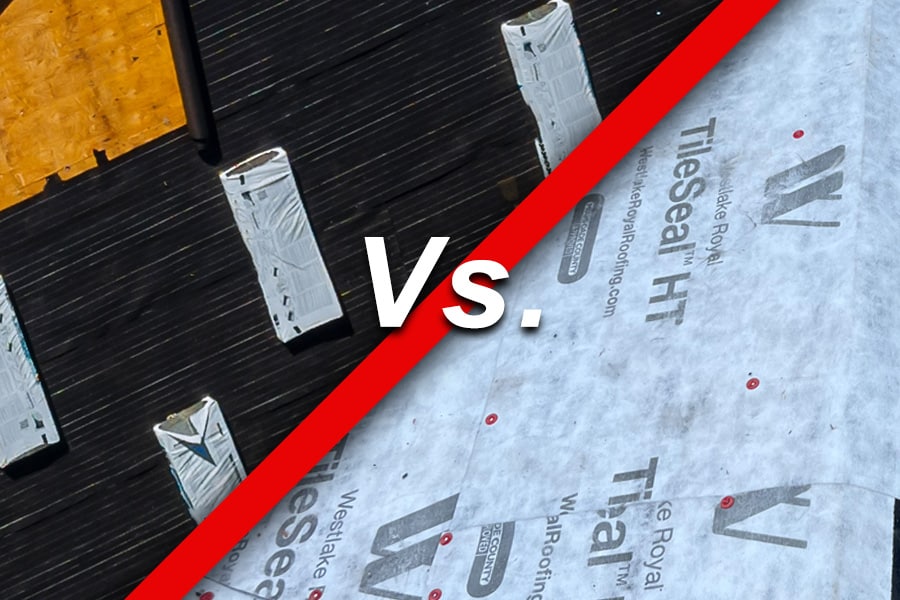Last week we dove into roof underlayment as it is an important piece of any tile roof. This week, we want to dive deeper into the differences between asphalt and synthetic underlayment. A quality underlayment should be water-resistant and act as a second life of defense against the elements. This is in case the roofing material is blown off or damaged during a storm, the underlayment will protect your home and prevent a leak.
There are three types of underlayment, two of which are asphalt-based and one that is synthetic. Each type of underlayment comes with its own set of advantages and disadvantages. As an industry leader with over 20 years of experience, Craven Construction is here to discuss each type of underlayment.
Asphalt-Saturated Felt Underlayment
Asphalt-saturated felt is the most commonly used underlayment, Likey because it is also the oldest type of underlayment. Most roofers choose asphalt felt since it is cost-effective and easy to install on roofs of every material.
This underlayment is made from an organic or fiberglass substrate that is saturated in crude oil byproducts to make it firm and water-resistant. Asphalt felt comes in 15 or 30-pound thickness. A 30-pound thick underlayment will provide better protection and last longer than the 15-pound.
Advantages
- Asphalt-saturated felt is the cheapest option of all underlayments.
- High-quality felt will help protect the roofing system in the event of material damage or failure.
Disadvantages
- Can easily tear in high winds or during installation.
- If exposed to moisture, especially during installation, the felt can absorb the water and wrinkle the felt. This can allow for shingles to curl and create a slippery surface.
- The weight of asphalt-saturated felt can cause issues as well. There are additional physical demands for the roof installers, with the greater with weight, the less material per roll.
Rubberized Asphalt Underlayment
A less popular asphalt underlayment is made from rubber polymers and asphalt. A rubberized asphalt underlayment will have a rubber-like look and feel to it. Most of these types of underlayment are offered in a peel-and-stick option. This helps with the waterproofing of the roof, protects your home from leaks, and will self-seal around nails and staples.
Rubberized asphalt underlayment is not only waterproof, but it also protects the home from UV rays should it be exposed. It can be left exposed to the elements for up to 180 days in most cases.
Advantages
- Rubberized asphalt underlayment is waterproof for complete protection for your home.
- It is easy to install, which keeps installation costs lower.
- Lifespan of up to 50 years.
Disadvantages
- This is the most expensive roofing underlayment option.
- You will want to check the fire rating if you live in an area susceptible to wildfires. Not all rubberized underlayments are fire-resistant.
- A professional roofer should complete the installation. This material can be difficult to manage or install, which can also increase the initial cost and make it even more expensive.
Synthetic Roofing Underlayment
Many roofers, including Craven Construction, are choosing a synthetic roofing underlayment to use under roofing materials. Typically made from long-lasting polymers, this material offers enhanced water resistance and significant protection from the elements, especially when compared to felt.
Synthetic roofing underlayment is a more recent development and underlayment option when compared to asphalt felt. This underlayment has become more popular in recent years and for good reasons. Below are the greatest advantages and a few disadvantages of using a synthetic roofing underlayment for your new roof.
Advantages
- Synthetic underlayment is extremely tough! Typically, it will not tear or become brittle from extended UV and moisture exposure.
- There is more material per roll of synthetic underlayment compared to felt and will be installed much faster. This underlayment is also up to 4x lighter than asphalt underlayment, making it easier to carry.
- A synthetic underlayment will repel water, unlike its felt counterparts that typically absorb it. This is important to help prevent water infiltration, especially if the roofing material is missing or damaged for an extended period of time.
Disadvantages
- Synthetic materials will come with a higher price, upfront. However, the cost of quality material will save you down the road, which can help offset the initial investment. The added peace of mind of knowing that your roof is well protected is also priceless.
Craven Construction offers synthetic roofing underlayment, exclusively. We firmly believe in offering the best products to our customers to ensure their home is protected from the elements. If you are in need of roofing work of any kind, contact our office today! We serve the entire East Valley with high-quality roofs of every shape, size, and material. Call our team to speak with our professionals and schedule your FREE roofing estimate!
Is your underlayment ready for replacement?
About Craven Construction
Craven Construction is dedicated to providing our customers with honest and reliable roofing services. With over two decades of residential and commercial experience, we are here to serve you and all of your roofing needs.
Our team of experienced roofers is licensed and knowledgeable in working with all types of roofing. We offer high quality roofing services and are capable of getting your project completed in a timely, efficient manner.

